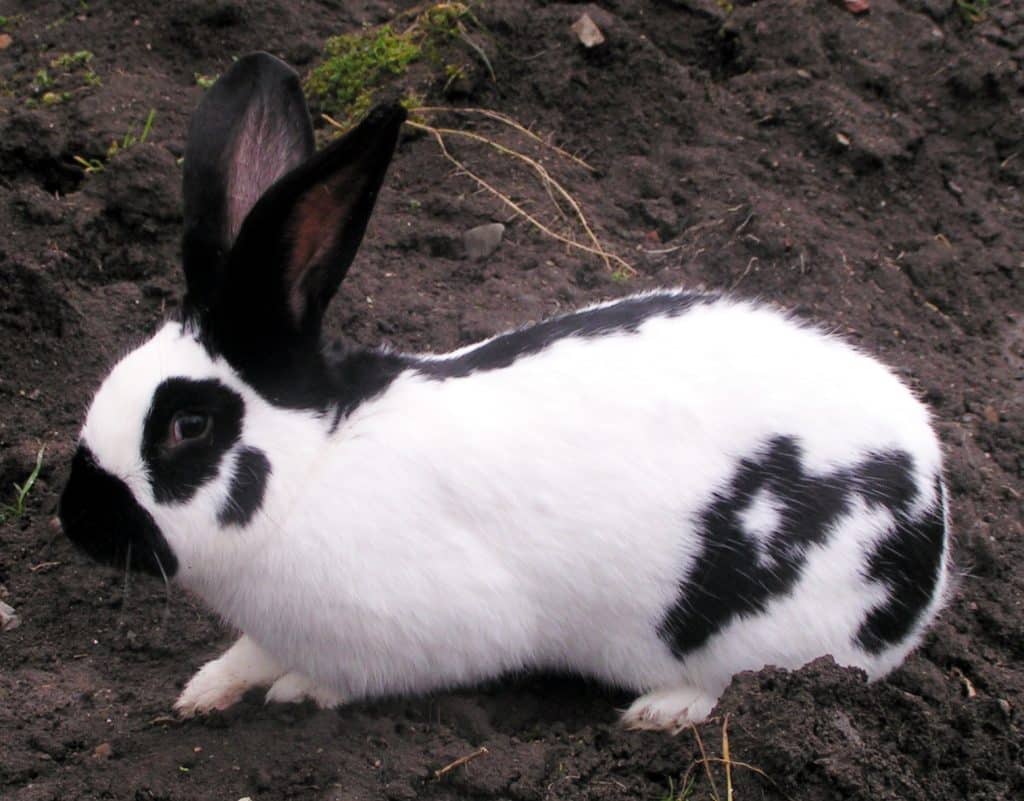The Checkered Giant rabbit is a big and beautiful breed. It has bold markings and a friendly personality. This guide will help you learn about its history, looks, behavior, and care. Whether you are new to rabbits or have experience, you will find helpful tips here.
Table of Contents
Introduction
The Checkered Giant rabbit is one of the largest breeds. It has a white coat with black or blue spots. The nose has a “butterfly” marking, and a stripe runs down its back. Despite its size, it is gentle and active. This guide will teach you about its history, care, and personality.

Checkered Giant Rabbit History and Origin
The Checkered Giant rabbit started in Europe in the 1800s. Breeders crossed large spotted rabbits with Flemish Giants. Otto Reinhardt, a breeder in 1904, helped create the breed by refining its pattern. The breed arrived in the U.S. in 1910 and became popular. Today, it is a favorite for shows and as a pet.
Physical Characteristics
This breed is large and lean. Bucks weigh at least 11 pounds, while does weigh at least 12 pounds. They have a long, arched body and strong legs. Their head is broad, and their ears are upright. They are built for speed and agility.
Distinctive Markings and Coat
Their coat is short, soft, and easy to care for. The breed has a white body with black or blue markings. Their most famous feature is the “butterfly” mark on their nose. They also have spots on their cheeks and a stripe down their back.
Temperament and Behavior
Checkered Giant rabbits are gentle but independent. They enjoy human interaction but do not always like cuddling. They are active and need space to run and explore. They can learn to use a litter box and respond to their name.
Diet and Nutritional Needs
These rabbits need a balanced diet:
- Hay: At least 70% of their food. It helps digestion and keeps their teeth healthy.
- Pellets: A small amount daily for extra nutrients.
- Vegetables: Leafy greens like romaine lettuce and kale.
- Fruits: Only as a treat because of sugar.
- Water: Always have fresh, clean water.
Exercise and Housing Requirements
Checkered Giants need a lot of space. They should have at least three hours outside their hutch each day. Their enclosure should be large and safe, with a solid floor to protect their feet. Toys, tunnels, and chew items keep them happy.
Grooming and Health Care
- Brushing: Once a week, more during shedding season.
- Nail Trimming: Regularly to prevent overgrowth.
- Ear and Dental Checks: Check for infections or overgrown teeth.
- Vet Visits: Regular checkups keep them healthy.
Breeding and Reproduction
Checkered Giants reach maturity at 12 to 18 months. They can have 11 to 14 kits per litter. Breeding requires careful selection to get the right markings.
Common Health Issues
- GI Stasis: A slow digestive system. Prevent with a high-fiber diet.
- Dental Problems: Overgrown teeth. Prevent with hay.
- Ear Mites: Check ears for scratching or redness.
- Joint Problems: Provide soft bedding to avoid pressure sores.
Lifespan and Daily Life
Checkered Giant rabbits live 5 to 8 years, sometimes longer. They need a set feeding and exercise routine. They enjoy exploring and need mental stimulation with toys and human interaction.
Tips for New Owners
- Prepare Your Home: Bunny-proof the area and remove hazards.
- Give Space: Provide a large enclosure and play area.
- Be Patient: Let them approach you for bonding.
- Regular Care: Stick to a feeding and grooming schedule.
Frequently Asked Questions (FAQs)
How much space does a checkered giant rabbit need?
A checkered giant rabbit needs a large enclosure—ideally a hutch with at least 3 ft x 3 ft x 4 ft of space. Additionally, they benefit from several hours of free-roaming time in a secure, bunny-proofed area daily.
What is the ideal diet for a checkered giant rabbit?
The ideal diet consists of high-quality hay (at least 70% of the diet), supplemented with measured portions of rabbit pellets and fresh vegetables. Fresh water should always be available. This balanced diet helps maintain healthy digestion and dental health.
Are checkered giant rabbits good pets for families?
Yes, checkered giant rabbits can be excellent pets for families with older children or experienced rabbit owners. Their gentle yet independent temperament makes them ideal for households that can provide the space and consistent care they need.
How often should I groom my checkered giant rabbit?
Grooming should be done at least once weekly, with increased frequency during shedding seasons. Regular brushing, nail trimming, and occasional ear and dental checks are recommended to keep your rabbit healthy and its coat looking its best.
What are the common health issues associated with checkered giant rabbits?
Common health concerns include gastrointestinal stasis, dental problems from overgrown teeth, and parasitic infections such as ear mites. Regular veterinary care, a high-fiber diet, and proper hygiene help prevent these issues.
Conclusion
The Checkered Giant rabbit is a stunning and unique breed. With proper care, it can be a wonderful pet. It needs space, a healthy diet, and regular interaction. If you are ready for the commitment, this rabbit can be a rewarding companion.
